The first thing that hits you in Oaxaca isn’t what you see—it’s what you smell. Roasting cacao mixed with wood smoke. Chile and chocolate grinding together. And if you’re brave, the earthy crunch of grasshoppers piled high at the market.
What is Oaxaca Known For?
Quick Answer: Oaxaca is known for seven varieties of mole sauce, artisanal mezcal, and Indigenous Zapotec/Mixtec cultures that survived Spanish conquest.
The region also produces world-class textiles, black pottery, and hosts Mexico’s most intense Day of the Dead celebrations. From ancient Monte Albán ruins to petrified waterfalls, Oaxaca offers cultural depth you won’t find anywhere else in Mexico.
Worth Your Time?
Skip If
3+ days minimum
You want beaches & resorts Best Oct-Nov (Day of the Dead)
You’re sensitive to spicy food Ultra-walkable historic center
You need English everywhere
Is Oaxaca Safe for American Tourists?
The Seven Sacred Moles (And Why Most Restaurants Mess Them Up)
Real Oaxacan mole takes days to prepare. Not hours. Days. This isn’t that chocolate sauce from Chipotle.
I watched a cook in Tlacolula market grind mole negro for three hours—just the prep work. Thirty ingredients including burnt tortilla, three types of chiles, chocolate, and spices I couldn’t identify. She was making it for her daughter’s wedding.
The Seven Types (Ranked By Complexity)
1. Mole Negro – The boss. Dark as midnight, takes 2 days, served at weddings. Over 30 ingredients.
2. Mole Rojo – My favorite. Brick-red, perfectly balanced between sweet negro and light amarillo. Best over chicken.
3. Coloradito – Reddish-brown, slightly sweet. Underrated.
4. Manchamantel – “The tablecloth stainer.” Contains pineapple. Yes, really.
5. Mole Verde – Green and herbaceous. Lighter summer option.
6. Chichilo – Smoky and mysterious. Hard to find outside Oaxaca.
7. Amarillo – Yellow from cumin, casual family meals. The “entry-level” mole.
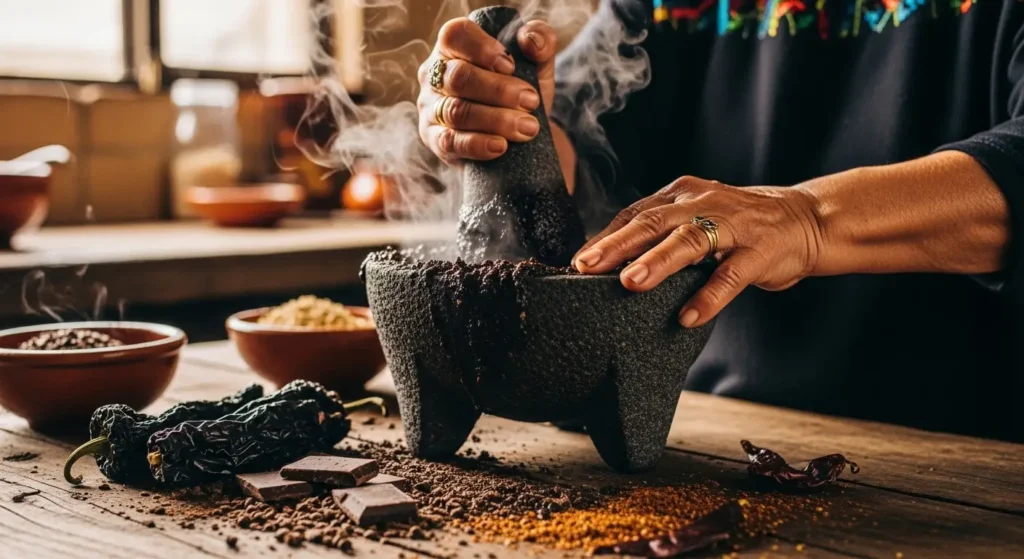
Tourist Trap Alert: If a restaurant has all seven moles ready to serve immediately, they’re not making them fresh. Real mole is made to order or in small batches.
Best Time to Visit Oaxaca Mexico
Mezcal: Not Just “Smoky Tequila” (That’s Like Calling Whiskey “Brown Vodka”)
Here’s what tourists get wrong: tequila is one type of mezcal, not the other way around.
Oaxaca produces 90% of the world’s mezcal using 30+ agave varieties. Tequila uses only blue agave from Jalisco. That’s like comparing wine made from 30 grape varieties versus wine from only Chardonnay.
The Real Difference
- Tequila: Steamed agave, industrial process, Jalisco
- Mezcal: Roasted in underground ovens (creates smokiness), artisanal family operations, Oaxaca
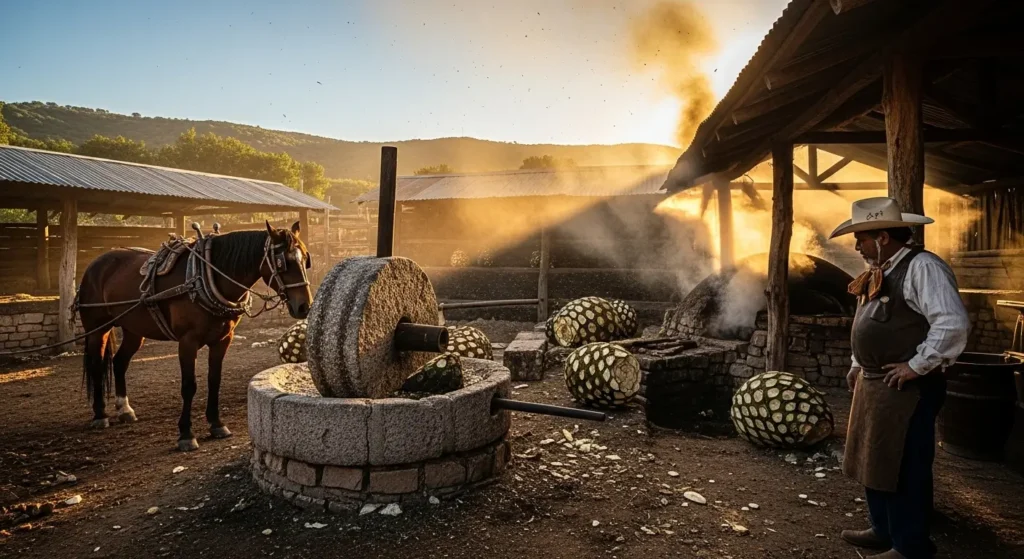
I visited a Palenque outside Santiago Matatlán where the maestro showed me agave that grew for 12 years before harvest. His grandfather taught him. His son now works beside him. The horse that pulls the stone wheel is the same horse from 15 years ago.
Villages Worth Visiting
Santiago Matatlán – “World Capital of Mezcal.” Palenques every few blocks.
San Dionisio Ocotepec – Wild agave from mountain hillsides. Expensive but worth it.
San Luis del Río – Fourth-generation producers using tahona (stone wheel pulled by horses).
Skip the tourist traps: Any place on the main highway with giant statues outside is overpriced. Ask your hotel for recommendations instead.
Indigenous Cultures That Actually Survived (Unlike Most of Latin America)
40% of Oaxacans speak Indigenous languages at home. Not as a second language. As their first language.
That’s not normal in Mexico. Or anywhere in Latin America.
Monte Albán: The Pyramids Everyone Ignores
Built around 500 BCE by Zapotecs, Monte Albán housed 25,000 people at its peak. That’s before Rome became an empire.
My guide was Zapotec. She pointed out carvings of conquered enemies, explained temple orientations to track solstices, and shared stories her grandmother told her about the site’s spiritual significance.
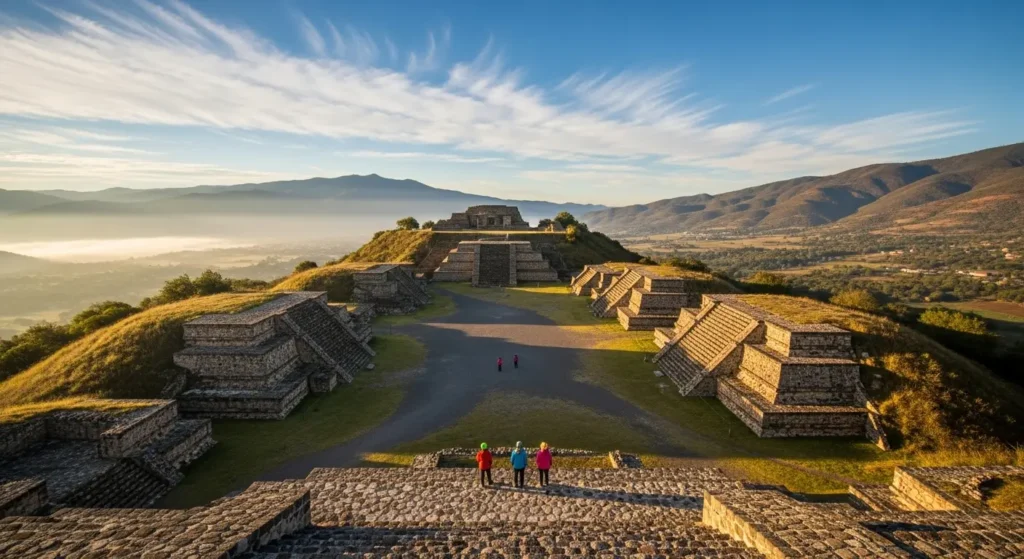
Pro tip: Go at opening time (8 AM) before tour buses arrive. The view alone is worth the early wake-up.
Teotitlán del Valle: Where Zapotec Is Still the Main Language
Thirty minutes from Oaxaca City, you’ll find a village where every family runs a weaving workshop. Not for tourists—they’ve been doing this for centuries.
I watched Don Miguel weave for hours. He learned at age 7. He’s now 52 and can create complex geometric patterns from memory. His daughter sat nearby carding wool by hand.
The rugs range from $50 to $5,000+ depending on size, complexity, and whether they use natural dyes. Collectors pay serious money for exceptional pieces.
What to buy: Look for natural dyes (cochineal red, indigo blue) and traditional Zapotec patterns. Synthetic dyes are cheaper but fade.
Things to Do in Huatulco Oaxaca
Textiles Worth More Than Your Car
Museum curators worldwide hunt for authentic Oaxacan textiles. Exceptional pieces sell for thousands.
The Natural Dye Process (It’s Insane)
Red: Comes from cochineal—tiny insects living on cactuses. Takes thousands of dried insects for one pound of dye. Produces everything from bright crimson to deep purple depending on mordants.
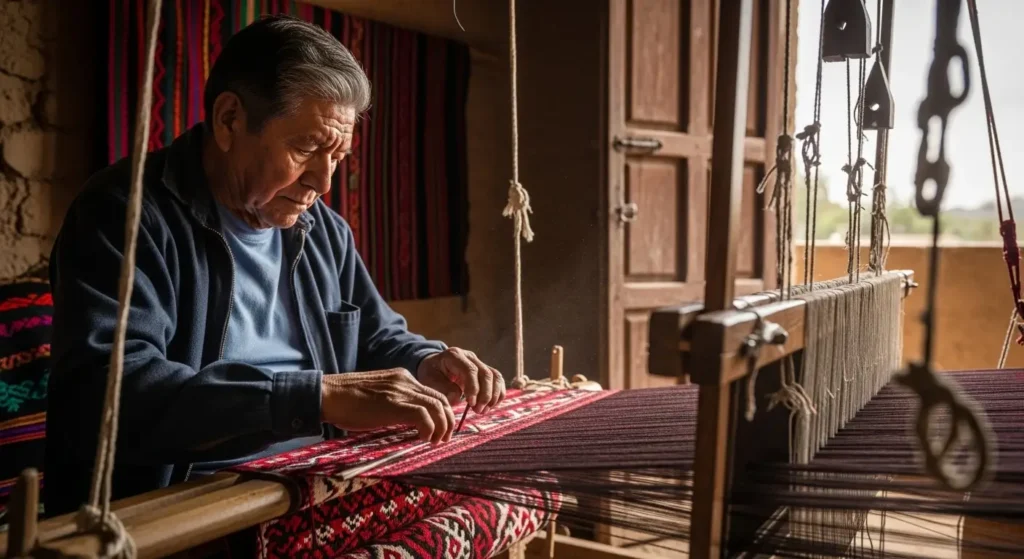
Blue: Indigo plants fermented for weeks. The process smells terrible but creates brilliant blues.
Yellow: Tree bark, flowers, pomegranate rinds.
Green: Mix blue and yellow (they can’t dye green directly).
Real talk: Natural dye pieces cost 3-5x more than synthetic. But they last generations and don’t fade. If price seems too good to be true, it’s synthetic.
Black Pottery That Exists Nowhere Else on Earth
San Bartolo Coyotepec makes barro negro—pottery fired to deep, reflective black that looks almost metallic.
The Secret Technique
The black doesn’t come from paint or glaze. It comes from the firing process.
Potters burnish pieces with smooth stones for hours (miss one spot and it shows). Then they fire in underground kilns sealed to restrict oxygen. The reduction atmosphere + iron-rich clay = that distinctive black sheen.
Doña Rosa Real Mateo perfected this in the 1950s, though the basic process is 2,000 years old.
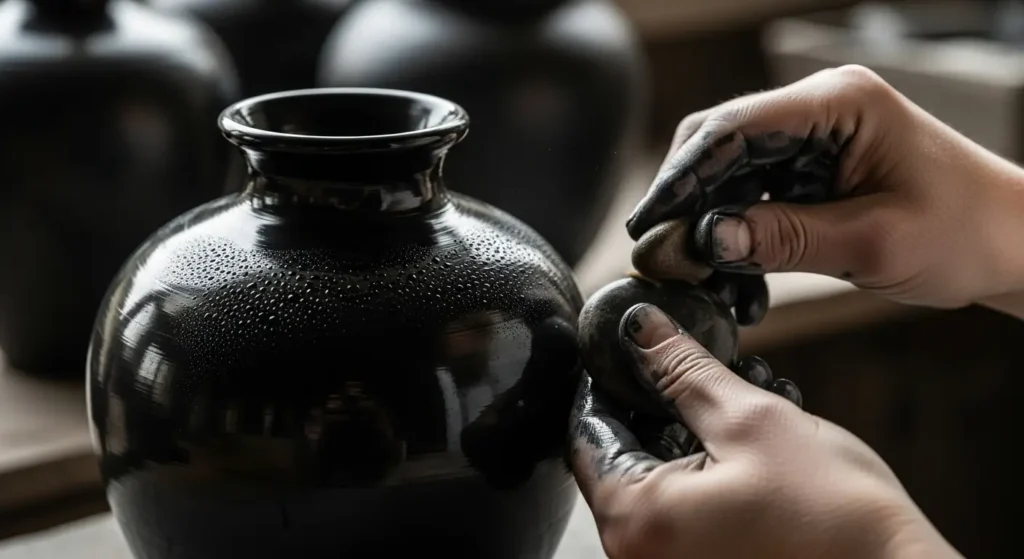
Warning: Real barro negro is expensive. Cheap knock-offs are painted black and chip easily. Real pieces have a natural sheen and weigh more.
Things To Do In Puerto Escondido Oaxaca
Alebrijes: Fever Dream Creatures Made Real
Six-foot giraffes covered in intricate patterns. Dragons with rabbit ears. Cats with wings.
These fantastical wood carvings started in Mexico City (1930s fever dream), but Oaxacan carvers transformed them into high art in the 1980s.
The Famous Artists
Jacobo and María Ángeles produce pieces selling for thousands. I stood in their gallery staring at a giraffe covered in traditional Zapotec patterns that took 6 months to paint.
María told me: “We’re not making toys. We’re continuing Zapotec artistic traditions in contemporary form.”
Where to buy: San Martín Tilcajete and Arrazola are the main villages. Gallery pieces cost $200-$5,000+. Small ones at markets start around $20.
Day of the Dead: Oaxaca Does It Different
Mexico is famous for Day of the Dead. But Oaxaca takes it to another level.
The entire state transforms in late October. Sand tapestry artists create elaborate murals that take days—then get swept away after one night. Families spend 24+ hours at cemeteries eating, drinking, playing music by graves.
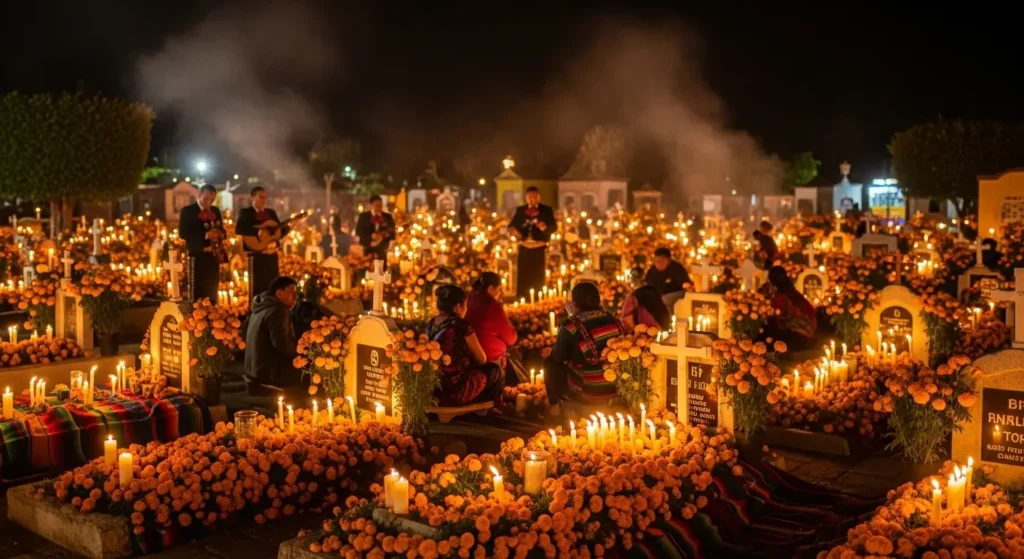
I attended at Xoxocotlán cemetery. Mariachi bands played between tombstones. Families spread blankets and shared meals. Kids ran around laughing. The atmosphere felt joyful, not sad.
The Guelaguetza Festival (July)
Representatives from seven regions perform traditional dances in native dress. Performers throw gifts to the audience—baskets, food, crafts—continuing the Zapotec tradition of reciprocal exchange.
Book early: Hotels fill up months in advance for both festivals.
Hierve el Agua: The “Frozen” Waterfalls That Aren’t Frozen
These aren’t ice. They’re mineral deposits that built up over thousands of years.
Mineral-rich spring water flows over cliff edges. As it evaporates, it leaves calcium carbonate deposits. The formations grow microscopically with each passing year.

The site name means “the water boils”—referring to how spring water bubbles up from underground. These springs create natural infinity pools where you can swim with valley views.
Pro tip: Go on weekdays. Weekends get crowded. The hike down to the formation base takes 45 minutes and offers the best views.
Street Food That Makes Chefs Book Flights From Paris
Oaxaca’s street food reputation extends worldwide. Chefs from New York, Paris, Tokyo make pilgrimages here.
What to Eat
Tlayudas – Massive crispy tortillas with beans, meat, cabbage, Oaxacan string cheese. Cooked over charcoal. The Oaxacan pizza.
Memelas – Thick corn cakes with raised edges holding toppings.
Chapulines – Grasshoppers with chile and lime. Crunchy, earthy, better than expected.
Tejate – Pre-Hispanic corn and cacao beverage. Looks weird. Tastes amazing.
My first tlayuda came from a street corner near Santo Domingo. The vendor worked over charcoal, folding and grilling until cheese melted. Cost: 60 pesos ($3.50). Better than restaurants charging 10x that.
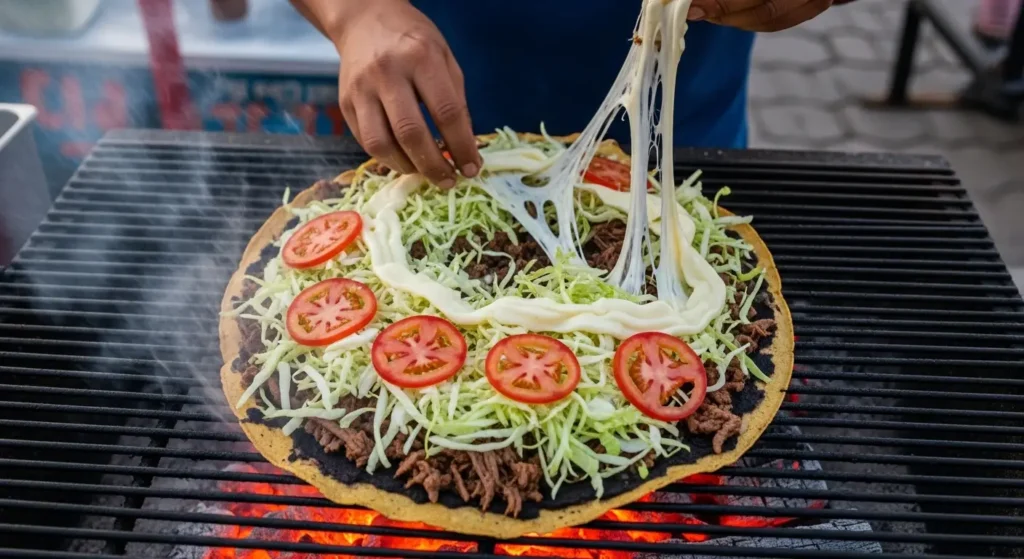
The Markets
Mercado 20 de Noviembre – Cooked food, chocolate grinding shops, mole vendors.
Mercado Benito Juárez – Crafts and souvenirs.
Mercado de Abastos – Where locals shop. Overwhelming in the best way.
Reality check: Markets can be intense. Loud, crowded, hot. If you’re not comfortable with that, stick to restaurants.
Oaxaca City: Colonial Beauty That’s Actually Alive
Unlike many UNESCO sites that feel like museums, Oaxaca City pulses with life.
The historic center radiates from the Zócalo. Santo Domingo church dominates—baroque masterpiece with golden interior that’ll make you gasp.
But here’s what makes it special: early morning, you’ll pass a 400-year-old church, then a contemporary art gallery, then a woman selling tamales from a basket, then a mezcalería serving craft cocktails.
The Contemporary Art Scene
Oaxaca’s affordable cost of living attracts artists from around Mexico and internationally. Galleries cluster around Alcalá street. Street art has exploded—entire facades covered in murals blending traditional imagery with contemporary themes.
Hot Chocolate & Coffee (Both Taken Seriously Here)
Oaxacan Chocolate
Forget Swiss Miss. Traditional Oaxacan chocolate is ground fresh with cinnamon, almonds, sugar—to your specifications. At Mercado 20 de Noviembre, shops grind it while you wait.
The result: intensely flavored, slightly grainy, thick enough to almost eat with a spoon.
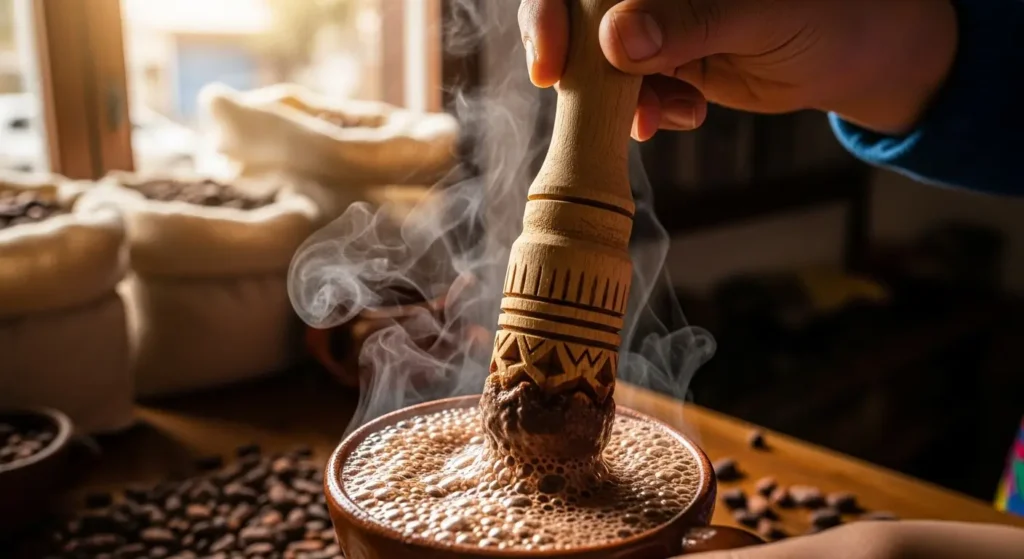
The Coffee
Oaxaca’s mountain regions (Pluma Hidalgo, Sierra Mazateca) produce exceptional specialty coffee. High altitude + volcanic soil + careful processing = beans with bright acidity and chocolate notes.
I spent a morning sampling different origins at a Jalatlaco café. Pluma Hidalgo: chocolate notes. Sierra Mazateca: brighter, fruitier.
Planning Your Trip: What Actually Matters
Best Time to Visit
What is the best time to visit Oaxaca?
October-November: Day of the Dead + comfortable weather. Book hotels 2-3 months ahead.
July: Guelaguetza festival but also rainy season.
December-February: Peak tourist season. Sunny, warm days, cool nights.
June-September: Rainy season. Brief afternoon storms, fewer tourists, lush landscapes.
My pick: Early November. Day of the Dead energy, rains ended, peak crowds haven’t arrived.
How Many Days
3 days: City + Monte Albán + one craft village
5 days: Add Hierve el Agua, more villages, mezcal tour
7-10 days: Beach trips, cooking classes, deeper exploration
Honest opinion: Most people wish they’d planned more time. This isn’t a quick-hit destination.
Getting Around
Oaxaca City is extremely walkable. Historic center spans ~15 blocks.
For villages: colectivos (shared vans) leave from Mercado de Abastos. Cheap but confusing at first.
Taxis: Always agree on price before getting in. Most short trips: 50-70 pesos.
Uber: Works and often cheaper than taxis.
Where to Stay
Luxury: Casa Oaxaca (rooftop pool, beautiful design), Quinta Real (restored convent)
Mid-range: Los Amantes (great location, affordable)
Budget: Pochon Inn, Casa Arnel (backpacker favorite for 40+ years)
Neighborhood tip: Historic center is convenient but noisy. Jalatlaco offers quiet while staying walkable.
What Makes Oaxaca Actually Different
After traveling throughout Mexico, Oaxaca feels different.
Indigenous presence isn’t performative—it’s daily life. Zapotec fills markets. Traditional dress is everyday clothing. Ancient techniques continue in workshops.
The food culture runs deeper. Seven mole varieties represent more sauce diversity than most cuisines achieve entirely.
Artistic traditions exist as living practices, not museum pieces. Families pass skills through generations while adapting to contemporary markets.
And Oaxaca resists homogenization. Few international chains. The city prioritizes local businesses, traditional architecture, cultural authenticity.
FAQ: What is Oaxaca Known For?
What is Oaxaca best known for?
Seven mole varieties, artisanal mezcal, strong Indigenous cultures, textiles, black pottery, alebrijes, and Mexico’s most intense Day of the Dead.
What food is Oaxaca famous for?
Mole (seven types), tlayudas, quesillo (string cheese), chapulines (grasshoppers), memelas, tamales, tejate.
Is Oaxaca Safe for American Tourists?
Generally yes. Lower crime rates than many Mexican destinations. Standard travel precautions apply. Tourist police patrol the historic center.
Can you drink the water in Oaxaca?
No. Bottled water is cheap and everywhere. Brushing teeth with tap water is usually fine.
Is Oaxaca worth visiting?
If you care about culture, food, or art—absolutely. If you want all-inclusive beach resorts—go to Cancún instead.
How much Spanish do I need?
More than in beach towns. English is common in touristy areas but rare in markets and villages. Basic Spanish significantly improves your experience.
What’s overrated in Oaxaca?
Monte Albán is impressive but not as spectacular as Chichen Itzá or Teotihuacan. Go anyway—it’s the history that matters, not the Instagram shots.

Really amazing and informative